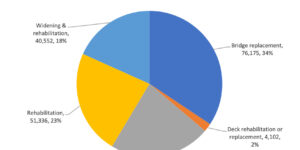For several years now, the commercial auto segment has been among the property/casualty insurance industry’s worst performing lines. Wounded by a sharp uptick in claims frequency and severity and helped little by inadequate premium increases, average direct loss ratios and combined ratio hover around 66 and 110, respectively.
Executive Summary
Although commercial auto remained one of the industry’s most troubled insurance lines in recent years, platooning big rigs, electric vehicles, telematic devices and computer vision cameras are putting the promise of safer roadways on the near-term horizon, experts in commercial transportation and insurance report.Opening Photo Tesla electric semi from Tesla online press kit
The market’s distress is attributed to a variety of higher loss exposures, including increasingly distracted and fatigued truck drivers and the high cost of repairing vehicles embedded with expensive collision avoidance cameras, sensors and telematics devices. The good news is that these same technologies are expected to positively alter the status quo, positioning commercial auto for a market rebound within the next five to 10 years.
Transportation experts project that semi-autonomous and fully autonomous electric trucks using crash avoidance sensors, cameras, telematics and deep learning forms of artificial intelligence will guide the way toward unparalleled safety. While semi-autonomous trucks equipped with lane correction and automatic braking systems are already on the road, fully autonomous/driverless vehicles are being tested across the country and the world.
Over the next decade, these trucks will gradually make their way into the nation’s transportation network, initially for long-haul delivery of goods on highways. Tests currently are being conducted in so-called “platooning,” which involves a convoy of trucks lined up in a row on a dedicated highway lane set aside specifically for their use. Only the first truck in the queue is driven by a human being; the remainder use automated driver support systems to maintain a specific distance behind the leader, accelerating and braking as dictated.
Since highway accidents result in the most severe commercial auto insurance claims (due to a greater risk of multiple fatalities), a future in which autonomous trucks travel along a dedicated lane bodes well for commercial fleet operators, their insurers and the driving public at large. In 2017, truck-related fatalities reached their highest level in 29 years, up 9 percent to 4,761 deaths. (Source: “Trucking Fatalities Reach Highest Level in 29 Years,” Trucks.com, Oct. 4, 2018, reporting on the U.S. Department of Transportation’s National Highway Traffic Safety Administration analysis, “2017 Fatal Motor Vehicle Crashes: Overview,” page 3)
Accident frequency rates are a different matter. In our Amazon-fueled era of ecommerce, more trucks and delivery vans are congesting shorter-distance routes, particularly in the so-called “last mile” of transport.
“Accidents are increasing because of crowded roadways and streets, driver inexperience, and the rush to deliver goods in a certain time frame,” said Steve Viscelli, senior fellow at the University of Pennsylvania’s Kleinman Center for Energy Policy. “What used to be an experienced UPS driver delivering a package here and there is now 20 or 30 part-time people in vans delivering dozens of small packages in very short time frames.” He’s referring to Amazon Flex and Uber Freight Plus—applications that link drivers with shippers to deliver smaller packaged goods.
These drivers are subject to both traditional collisions and non-accident-related injuries. “There’s been an increase in basic ‘slips and falls’ from drivers bringing bulky packages into a residence,” Viscelli said. “Drivers also double park and fail to use proper techniques for removing heavy packages, hurting their backs. Of course, all that congestion and the need to make so many deliveries in a certain time frame also results in a greater number of collisions.”
Despite higher claims activity, technology is seen as an eventual enabler for safer practices, reducing both accident frequency and severity. Telematics drawing data from onboard cameras and other sensors will alert fleet safety managers in real time to road hazards, weather conditions, vehicle malfunctions, traffic congestion and optimal alternate routes.
As insurers and commercial fleets—large semi tractor-trailers, intermediate-sized trucks, and smaller pickups and vans—begin to share their respective data, expectations are for truly significant decreases in accident-related claims. “In five to 10 years, we will see a period of fast-maturing safety,” said Randy Mancini, vice president of commercial lines at regional insurer Penn National. “Beyond that we will see a transportation system that looks little like the one we’ve long known.”
Handing Off the Baton
This future is already beginning to materialize, evident in subtle changes in the intermodal delivery of raw materials and packaged goods. “Historically, the system has relied on rail, semi tractor-trailers, and smaller trucks and vans,” said Viscelli, author of the book, “The Big Rig: Trucking and the Decline of the American Dream.” “In the expanding ‘I want it now’ ecommerce environment of the future, rail will take on a larger role transporting goods from shipping ports to large warehouse-like depots alongside major highways.”
Fully autonomous trucks will then pick up these goods for transport over long distances in a dedicated highway lane to another depot, Viscelli added. “From there, a semi-autonomous, intermediate-sized truck will transport the stuff on shorter distances to an Amazon or other fulfillment center,” he said. “Smaller trucks and vans driven by for-hire drivers will then handle the last mile of delivery to homes and businesses, as they do now.”

This scenario, assuming it comes to fruition, will result in fewer accidents on highways. “If lawmakers and regulators set aside a designated lane exclusively for self-driving trucks, the chance of a passenger car cutting off a truck is vastly reduced—to the benefit of commercial fleets, drivers and insurers,” said Frank Palmer, senior expert in McKinsey & Company’s insurance practice.
Frank Netcoh, head of middle-market auto for The Hartford, shares this perspective. “If you have a fully autonomous truck on a big stretch of highway designated specifically for these vehicles, the platooning concept would reduce the possibility of making a mistake,” Netcoh said. “It’s hard to get into a collision when no ‘driver’ is screwing up.”
What about the safety of shorter-duration transport vehicles driven predominantly by people?
The experts are optimistic that safety enhancements warning drivers about impending hazards and correcting vehicles to reduce the risk of rear-end collisions, unsafe lane departures and rollovers (caused by the unequal distribution of weight inside a truck) will also increase safety and reduce accident frequency.
“These crash avoidance technologies are already in use today, but the real ‘game changer’ in my mind is telematics—the movement of information from onboard cameras and sensors to fleet safety managers,” said Brian Fielkow, CEO of JETCO Delivery, a logistics business that specializes in regional trucking, heavy haul and national freight.
Depending on the telematics device, a two-way camera films both driver behaviors and the road ahead. If a truck is in an accident, the data can indicate what the driver was doing just prior to the collision—such as reading a text, eating or drinking, or blankly looking ahead with shoulders slumping and eyelids shuttering from fatigue (the camera captures a driver’s body position, in addition to his or her face). This information can then be used for evidence-based training purposes. “It’s like watching game films—a learning tool,” said Fielkow. “Even the best driver isn’t a perfect driver.”
Front-looking cameras, on the other hand, can discern the different factors leading up to an accident or a near-miss. “A trigger event like a hard brake will inform the telematics to send video depicting the road scene a few seconds prior,” Fielkow explained.
In accidents in which a truck rear-ends a vehicle, the video can be the difference between a very expensive claim and no claim at all. “Traditional investigations of an accident almost always attribute the cause of the collision to the vehicle in the rear,” said Fielkow. “However, the video may indicate that the driver of the rear-ended vehicle was swerving in and out of traffic and actually cut off the truck, altering liability.”
“Regrettably, people who get into an accident with a truck see that big name sprawled across the side and tend to blame the company,” said Jennifer Haroon, Nauto chief operating officer and formerly head of business operations at Waymo (Google’s self-driving car project). “Our video evidence exonerates a lot of drivers.”
Gizmos and Gadgets
Telematics devices are becoming increasingly more sophisticated and less expensive, encouraging wider use by fleet operators. The visual sensors, for instance, are smaller, even though the semiconductors within them are more powerful. Sandeep Pandya, president of Netradyne, another maker of computer vision cameras, attributes the enhancements to ongoing technological advancements in smartphones.

“We’re in an age of powerful computing capabilities and ubiquitous connectivity via 4G broadband cellular technology,” he said. “Using deep learning, algorithms can automatically draw insights from visual images, accelerometers, gyroscopes and other sensors…Mass quantities of other data like the weather and road conditions also can be analyzed to guide safer driver behaviors.”
That’s uplifting for both truck fleets and their drivers, an employment category where demand far outstrips supply. The American Trucking Association estimates that the transportation industry needs to hire nearly 900,000 additional drivers to meet rising demand for service. Few young people want to drive a truck for a living. (The average age of truck drivers is 55, according to some sources; the ATA puts the average age of just over-the-road, for-hire drivers a little lower, at 49.)
“Professional truck drivers drive 50 hours a week and 150,000 miles per year on average; they take great pride in what they do,” said Pandya. “Almost the entirety of their work is uneventful, but it’s that 2 percent in which they confront hazardous conditions that define them. Following an accident, drivers feel vilified, making it hard for the industry to retain them. Telematics is a way to determine the best of the best for retention purposes.”
Netradyne’s cameras, he explained, will ferret out positive driving behaviors as well as negative ones. “You’re now able to know which drivers are the most safety conscious,” said Pandya. “This gives a truck company the opportunity to address its driver shortage problems; instead of spending $10,000 to recruit a new driver, it can put it toward a bonus rewarding its best drivers.”
Filming a truck driver’s entire time at the wheel creates privacy issues, hence both Netradyne and Nauto have designed their telematics devices to produce short video streams of the triggering safety event, such as images of what the driver was doing immediately preceding the accident. This information is automatically provided to fleet safety managers to reduce driver distractedness and isolate factors causing drivers to become fatigued.

Interestingly, the introduction of electric trucks like Tesla’s first semi tractor-trailer, Tesla Semi, is expected to reduce driver weariness. “Electric vehicles produce less noise and vibration and are easier to drive, helping drivers remain vigilant for longer periods of time,” explained Chris Nordh, senior director of advanced vehicle technologies at Ryder System Inc., a provider of rental trucks and fleet management systems. “Reports indicate that drivers are not as exhausted at the end of the day.”
Electric trucks also are able to withstand more of the damage caused by a collision, said Nordh’s colleague Amy Wagner, Ryder vice president of global product insurance and risk management. “Crash data indicates that electric vehicles are the safest vehicles on the road in the event of an accident,” said Wagner. “Electric vehicles are built on what is called a ‘skateboard platform,’ where the batteries are built right into the frame. This creates a vehicle with a low center of gravity that is also a massive piece of metal. Not surprisingly, we’re at the forefront of bringing more commercial electric vehicles into our fleet.”
Beginnings of a Long-Term Partnership
Insurers are bullish on these varied technological and intermodal transport developments. A case in point is Penn National, which provides financial grants to truck insureds interested in implementing telematics and other safety equipment. “We’ll split the cost of the technology 50-50 up to $2,500, in return for feedback on what the data indicates about claims reductions,” said Mancini. “We can then learn from this data in terms of our underwriting and pricing.”
Other insurers perceive similar value in having policyholders share their experiential data. “It gives us the opportunity to provide more insightful consultation to fleet safety managers,” said Tony Fenton, vice president of Underwriting and Product for Commercial Auto, Casualty and New Product Development at Nationwide. “It puts our loss control/risk management professionals in more of an ‘I know’ environment.”
Netcoh from The Hartford agrees, noting that the insurer’s focus in 2019 is to more closely engage with its truck insureds to better understand their use of telematics. “We’re looking to dovetail their work with the research conducted by our safety risk engineers to improve loss costs,” he explained. Telematics has yet to evolve into a really close data-sharing relationship.”
That’s true. However, Fenton predicts that within the next five to 10 years, such sharing of data will be business as usual. “I can see a day when insureds provide us information on how many drivers are on the road, who these drivers are and how they are driving, and we provide to them information on the location of the vehicle in relation to the accident history of a particular stretch of highway based on weather conditions, traffic congestion and driver time at the wheel,” he said. “As more data becomes available and is shared, insurers can rate a client based on real-time exposures, as opposed to traditional rating programs driven by the type or class of vehicle.”
Wagner from Ryder concurs, pointing to the opportunity for insurers, truck companies and diverse other parties like repair shops to engage in an ecosystem-like software platform. “When you start bringing all these diverse sources of data together, you can create driver scorecards as a means of positive reinforcement to compel better driving behaviors,” she said. “Those scorecards can then make their way into lower insurance rates.”
Need for New Types of Insurance?
As commercial fleets incorporate more autonomous safety features into their trucks, traditional commercial auto policies may need to accommodate new causes of liability. For instance, a collision may not be the result of driver error but in fact be caused by a sensor failure, software glitch or a cyber attack.
Insurer Chubb is presently mulling this new risk landscape. “We have to be prepared to address these new liabilities,” explained Dave Brown, executive vice president and transportation leader in Chubb’s Major Accounts Division.
There are two schools of thoughts on how insurance policies may need to change. “One is whether or not the current commercial auto liability policy is still the appropriate mechanism, assuming some adjustments,” Brown explained. “The other surrounds the use of product liability policies as an alternative or conjunct to commercial auto.”
While Brown is “on the fence,” he said, regarding which concept is best, he believes the longstanding commercial auto policy has a lot of positives to commend it. “For one thing, it allows for claims to be efficiently administered to rapidly take care of injured victims and make them whole financially, whereas product liability claims are highly litigious—consuming time and costs,” he explained. “If a loss is attributed to a sensor or software defect, my thinking is that the commercial auto policy should be the mechanism for the adjudication and payment of the claim, with this insurer subrogating the product manufacturer’s insurer for the loss.”
Down the line, the experts believe that commercial fleets will inevitably become safer. “The next wave is for all these remarkable cameras and sensors to send their data over the Internet to be analyzed with other types of data like historical loss patterns, real-time weather conditions, traffic congestion and even the Department of Transportation’s data on roadside inspections,” said Fielkow. “Really, the sky’s the limit here. Algorithms can then dig through these massive data volumes to unearth specific areas for continuous safety improvements.”
As this happens, Fielkow can see a day when commercial auto insurers and truck carriers work closely together to help each other become smarter about risk management and loss prevention, he said. That’s good news for both parties and for all of us who regularly venture onto a highway.





















 Retail Workers Consider Quitting Due to Safety Concerns Ahead of Holiday Shopping Season
Retail Workers Consider Quitting Due to Safety Concerns Ahead of Holiday Shopping Season  Insurance Ranks in the Top 5 Most Affected Industries When It Comes to Identity Fraud
Insurance Ranks in the Top 5 Most Affected Industries When It Comes to Identity Fraud  Florida Home Sales Decline Amid Hurricane Recovery, Surging HOA and Insurance Costs
Florida Home Sales Decline Amid Hurricane Recovery, Surging HOA and Insurance Costs  Four Arrested for Insurance Fraud in Fake Bear Attack
Four Arrested for Insurance Fraud in Fake Bear Attack 







